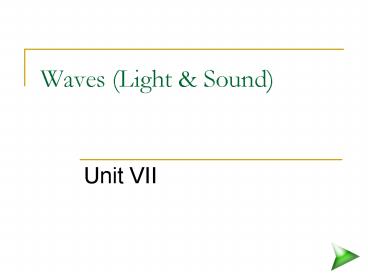Waves Light
1 / 17
Title: Waves Light
1
Waves (Light Sound)
- Unit VII
2
Types of Waves
- Transverse Wave Causes the particles of the
medium to vibrate perpendicularly to the
direction of motion of the wave. - Longitudinal Wave Causes the particles of a
medium to move parallel to the direction of the
wave.
3
Types of Waves
- Surface Waves A mixture of transverse and
longitudinal waves. - Wave Pulse A single disturbance that travels
through a medium. - Traveling Wave A source that is vibrating with
simple harmonic motion will produce a continuous
traveling wave.
4
The Measure of a Wave
- Period (T) The shortest time interval during
which the motion repeats itself. - Frequency (f) The number of complete vibrations
per second measured at a fixed location.
Frequency is measured in hertz. - One hertz (Hz) is one vibration per second or f
1 / T
5
Example
- A sound wave has a frequency of 262 Hz. What is
the time between successive wave crests? - f 262 Hz
- T 1 / 262 Hz
- T .00382 s
6
The Measure of a Wave
- Wavelength ( ?) The shortest distance between
points where the wave pattern repeats itself. - Crest (C) Are the high points of each wave
motion. - Troughs (T) Are the low points of each wave
motion. - Eq v ? / f
7
Wave Parts
- Wave Parts
8
Example
- A sound wave with frequency 262 Hz has a
wavelength of 1.29 m. What is the velocity of the
sound wave? - f 262 Hz
- ? 1.29 m
- v (1.29m)(262 Hz)
- v 338 m/s
9
Waves
- Amplitude the maximum displacement from the rest
or equilibrium position. - Often a wave moves from one medium to another.
Light moves from air into water. Suppose a wave,
called the incident wave, reaches the boundary of
a medium. Part of the energy carried by the
incident wave continues on in the new medium as a
wave of same frequency. This wave is called the
transmitted wave. Part of the energy moves
backward from the boundary was a wave in the old
medium. This wave is called the reflected wave.
10
Superposition of Waves
- What happens when two or more waves travel
through a medium at the same time? - Each wave affects the medium independently.
- Principle of Superposition The displacement of a
medium caused by two or more waves is the
algebraic sum of the displacements caused by the
individual waves.
11
Superposition of Waves
- Interference The result of the superposition of
two or more waves. - Constructive Interference When the wave
displacements are in the same direction. The
result is a wave with larger amplitude than any
of the individual waves. - http//id.mind.net/zona/mstm/physics/waves/interf
erence/constructiveInterference/InterferenceExplan
ation2.html - Destructive Interference Two pulses with equal
but opposite amplitudes. As the two pulses
overlap, the displacement of the medium at each
point in the overlap is reduced. When the pulses
are at the same location, the displacement is
zero.
12
Standing Waves
- Node One point in the medium that is completely
undisturbed at all times. At a node, the medium
is never displaced. - Antinode One point that undergoes the greatest
displacement. Its maximum amplitude is equal to
the sum of the amplitudes of the two pulses.
13
Standing Waves
- Standing Wave Has stationary nodes and
antinodes. It is the result of identical waves
traveling in opposite directions.
14
Reflection of Waves
- Normal The direction of the barrier is also
shown by a line drawn at a right angle to it. - Angle of Incidence The angle between the
incident ray and the normal. - Angle of Reflection The angle between the normal
and the reflected ray. - Law of Reflection States that the angle of
incidence is equal to the angle of reflection.
15
Refraction of Waves
- Refraction The ? of wave direction _at_ the
boundary between 2 media.
16
Diffraction Interference of Waves
- Diffraction The spreading of waves around the
edge of a barrier.
17
Quiz
- Quiz































